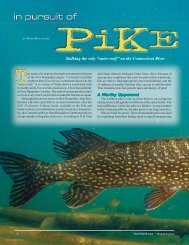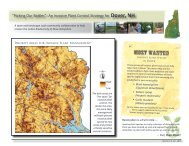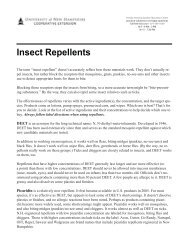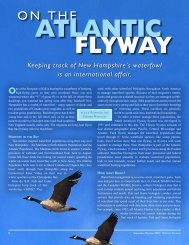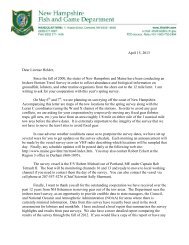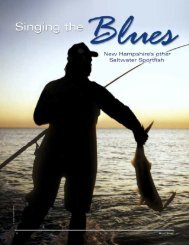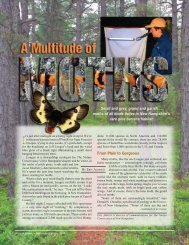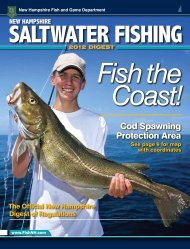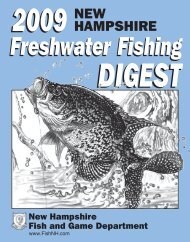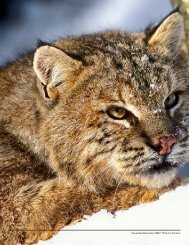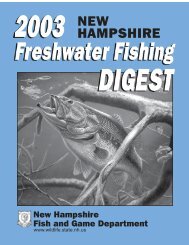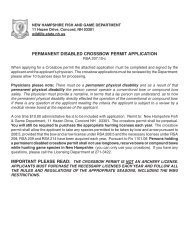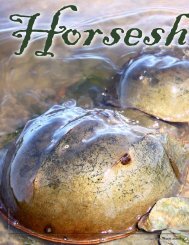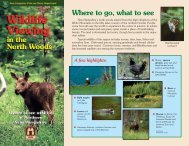©JIM BLOCK PHOTONorthern parulaGet Out <strong>and</strong> ExploreThe trail is a “great idea because it gets peopleout there looking at birds, <strong>and</strong> hopefully thatinterest will lead to stewardship,” said Pam Hunt,a bird conservation biologist with N.H. Audubon<strong>and</strong> coordinator of the state’s Important Bird AreaProgram. “The <strong>Birding</strong> <strong>Trail</strong> shows people linkageswith the river, which is animportant flyway,” Hunt said. Thesouthern stretch of the river fromClaremont to the Massachusetts borderhas recently been identified as an ImportantBird Area, largely because it is a major corridorfor migrating waterfowl that rest <strong>and</strong> feed on itsimpoundments, marshes <strong>and</strong> setbacks. This stretchof the river also hosts two bald eagle nests.Sites along the <strong>Connecticut</strong> <strong>River</strong> <strong>Birding</strong> <strong>Trail</strong>give people a chance to discover a rich diversity ofhabitats. “We have wonderful forests <strong>and</strong> wetl<strong>and</strong>s.Why not get outside <strong>and</strong> explore the naturalenvironment we have in the region?” says Shepard.The Otter Brook Lake site in Keene, for example,owned by the Army Corps of Engineers, featureswetl<strong>and</strong>s, old fields, shrub <strong>and</strong> forest habitats thatsupport many different bird species.Part of the fun is discovering regional differencesalong the trail. North Country sites, like the<strong>Connecticut</strong> Lakes Headwaters Natural Areain Pittsburg (another ImportantBird Area), have a unique habitat<strong>and</strong> ecology that can sustainHow tobird species not often found inOrdersouthern reaches, includingspruce grouse, gray jay <strong>and</strong>Mapsblack-backed woodpecker.Wildlife educator Judy Silverberg, N.H. <strong>Fish</strong><strong>and</strong> <strong>Game</strong>’s liaison to the project, agrees that thesites serve many users. Since Texas first launchedthe birding trail idea, “the concept has spread toother states <strong>and</strong> become a way to identify sites ofinterest for multiple audiences,” Silverberg said.“<strong>Birding</strong> sites often coincide with other wildlifeviewing opportunities <strong>and</strong> areas of other natural orcultural interest.”Saint-Gaudens National Historic Site, in Cornish,is a perfect example. This historic home of anoted American sculptor is also a site on the<strong>Birding</strong> <strong>Trail</strong>. Its 150-acre grounds include trailsthat wind through numerous habitats where visitorscan watch for ruby-throated hummingbirds,cedar waxwings <strong>and</strong> scarlet tanagers.Hikers <strong>and</strong> bikers will enjoy the Northern Rail<strong>Trail</strong>, which stretches 23 miles from Lebanon toGrafton, offering easy birding from the rail bed asit passes through a variety of habitats, includingfields, woods <strong>and</strong> wetl<strong>and</strong>s. More than 100 birdspecies have been recorded along this trail, includingthe pied-billed grebe, American woodcock <strong>and</strong>Baltimore oriole. Further north at PondicherryWildlife Refuge in Whitefield, also an identifiedImportant Bird Area, you’ll find a great diversityof birds (234 species, 135 breeding species), butalso spectacular mountain scenery, easy walking,isolation <strong>and</strong> wildlife.The maps include recommended times forbirders to visit the sites, usually from spring throughfall. “May st<strong>and</strong>s out as a prime birding month.Many migrating birds are coming <strong>and</strong> going, settingup nesting territories. Life is exploding. There’slots of singing <strong>and</strong> the birds are in their best springplumage,” said Shepard. “But don’t forget oppor-©JIM BLOCK PHOTO<strong>Connecticut</strong><strong>River</strong> <strong>Birding</strong> <strong>Trail</strong> mapsfor the Northern, Central <strong>and</strong>Southern sections (NH/VT) are free, butcontributions are welcome. Visitwww.ctriverbirdingtrail.org to ordermaps or make a donation. Maps are alsoavailable from N.H. <strong>Fish</strong> <strong>and</strong> <strong>Game</strong>; emailinfo@wildlife.state.nh.us or call(603) 271-3211. Please specify whichmaps you want to get.<strong>Birding</strong> <strong>and</strong> MoreBirds aren’t the only attraction.“It’s called a birding trail,but when you’re going to thesebeautiful spots, you’ll see lotsof different wildlife,” saysShepard. “It’s really a naturalhistory trail. You can also seemany different butterflies, dragonflies<strong>and</strong> mammal tracks.”Bill Shepard (in green jacket), the driving forcebehind the development of the <strong>Connecticut</strong> <strong>River</strong><strong>Birding</strong> <strong>Trail</strong>, leads a bird walk at one of thetrail’s prime viewing sites.16 March/April 2007 • WILDLIFE JOURNAL
Can You Find These Seldom-seen Birds?<strong>Birding</strong> along the <strong>Connecticut</strong> <strong>River</strong> <strong>Birding</strong><strong>Trail</strong> may bring you in contact with some of<strong>New</strong> <strong>Hampshire</strong>’s species of greatest conservationneed, as listed in the state’s WildlifeAction Plan. Here are a few to look for:Pied-billed grebes, endangered in <strong>New</strong><strong>Hampshire</strong>, are small, compact birds with ashort, thick bill. Look for the distinctive ringaround the bill.Pied-billed grebeThese birdsprefer wetl<strong>and</strong>swithdense st<strong>and</strong>sof emergentplants for hiding,but needopen water fortake-offs <strong>and</strong> l<strong>and</strong>ings. They nest on a platformof vegetation in the emergent plants,near the water surface <strong>and</strong> in shallow areas,making them vulnerable to changes in waterlevel. <strong>Fish</strong> <strong>and</strong> <strong>Game</strong> is considering a managementplan for pied-billed grebes forMacDaniel’s Marsh in Grafton, one ofthe <strong>Birding</strong> <strong>Trail</strong> sites.Look for northern harriers flyinglow over open areas. A white patch atthe base of the tail is a distinctive fieldmark. Harriers inhabit grassl<strong>and</strong>s <strong>and</strong>marshes with open areas for foraging.©DAVID HERR USFS PHOTOIn <strong>New</strong> <strong>Hampshire</strong>, they breed in Coos County<strong>and</strong> Danbury, nesting on the ground inshrubby areas adjacent to hayfields, pasture,old fields <strong>and</strong> wetl<strong>and</strong>s. In the winter,they can be seen flying over coastal saltmarshes. Northern harriers are endangeredin N.H. Several of their nesting sites in <strong>New</strong><strong>Hampshire</strong> are protected, including the WhitefieldAirport (a site on the <strong>Birding</strong> <strong>Trail</strong>),which manages the grassy habitat cooperativelywith <strong>Fish</strong> <strong>and</strong> <strong>Game</strong>.Warblers are jewels of the forest, withtheir bright colors, lovely songs <strong>and</strong> variedhabits. In <strong>New</strong> <strong>Hampshire</strong>, four species arelisted as species of greatest conservationneed in the N.H. Wildlife Action Plan. All havebeen seen in the <strong>Connecticut</strong> <strong>River</strong> system,but are rare. The bay-breasted <strong>and</strong> palmwarblers nest in northern <strong>New</strong> <strong>Hampshire</strong> inconiferous forests. Bay-breasted warblersseek small forest openings so they can foragefor insects in the thick conifers at theedge. PalmNorthern harrier warblers preferbogs <strong>and</strong>fens in borealforests, a habitatvery difficultto access, sobirders should©JIM BLOCK PHOTOlook for themduring thePalm warblerspring migration.Ceruleanwarblersprefer hardwood<strong>and</strong>floodplain forestswith talltrees. In the southern <strong>Connecticut</strong> <strong>River</strong> area,they may be found in the Ashuelot <strong>River</strong>floodplain <strong>and</strong> on the steep slopes of Mt.Wantastiquet Natural Area. This species hasseen a major decline throughout its range<strong>and</strong> has been nominated for federal threatenedstatus.Golden-winged warblers prefer ab<strong>and</strong>onedfields, clearcuts <strong>and</strong> power lines, wherethey nest in shrubs, sometimes interbreedingwith blue-winged warblers. They are atrisk from invasive plant species, such as theautumn olive, <strong>and</strong> from habitat fragmentationthat exposes their ground nests topredators.As you enjoy your birding, watch for these<strong>and</strong> other rare species. Learn more in thespecies appendix of the <strong>New</strong> <strong>Hampshire</strong>Wildlife Action Plan at www.WildNH.com.— Emily Brunkhurst©ROGER IRWIN PHOTOtunities later in the year, like looking for fallwarblers or watching for hawks at Pack Monadnock.The excitement is going back to these placesagain <strong>and</strong> again.”When enjoying these sites, remember you’re aguest. “We want these sites to remain open, soplease respect the properties <strong>and</strong> the wildlife,”said Shepard. Tread lightly, stay on trails <strong>and</strong> parkin designated areas. Enjoy, but don’t disturb thebirds’ normal activities. Stick to “pishing” (makingsqueaking or “kissing” sounds) to attract birds,rather than using recording devices. Leave yourdog at home.Protecting our FutureBirders <strong>and</strong> other outdoor enthusiasts can usethe <strong>Connecticut</strong> <strong>Birding</strong> <strong>Trail</strong> maps to discoverproperties owned by a wide range of entities —state parks or forests, federal preserves, <strong>Fish</strong> <strong>and</strong><strong>Game</strong> l<strong>and</strong>s, N.H. Audubon sanctuaries <strong>and</strong> townl<strong>and</strong>s. These partner organizations – <strong>and</strong> manyvolunteers – made the project possible, saysShepard. The successful two-state collaborationreminds us that we are connected by habitatregardless of political boundaries.While the <strong>New</strong> <strong>Hampshire</strong>/Vermont section ofthe trail is now complete, the <strong>Connecticut</strong> <strong>River</strong><strong>Birding</strong> <strong>Trail</strong> has the potential to continue southward.Eventually the vision is to have one trail thatcovers sites in the entire 400-mile <strong>Connecticut</strong><strong>River</strong> watershed, including segments in Massachusetts<strong>and</strong> <strong>Connecticut</strong>. A similar project is inthe planning stages for the Merrimack <strong>River</strong>Valley.Conservationists <strong>and</strong> birders created the<strong>Connecticut</strong> <strong>River</strong> <strong>Birding</strong> <strong>Trail</strong> with hopes that anincreased involvement in, <strong>and</strong> appreciation for,our areas natural l<strong>and</strong>scapes would inspire thepublic to protect remaining resources. These specialplaces beckon for our involvement, concern<strong>and</strong> stewardship to ensure the conservation of <strong>New</strong>Engl<strong>and</strong>’s rich biodiversity. Plus, it’s a fun way tofind new places to go birding!Emily Brunkhurst is a conservation biologistwith <strong>Fish</strong> <strong>and</strong> <strong>Game</strong>’s Nongame <strong>and</strong>Endangered Wildlife program. JaneVachon is associate editor of NHWJ.Public Affairs Intern Kat Bagley contributedwriting <strong>and</strong> research for this article.Ruby-throatedhummingbird©MATT PALMER PHOTOWILDLIFE JOURNAL • March/April 2007 17



